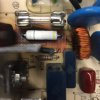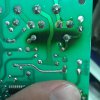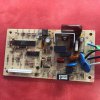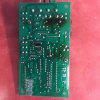Sir Warhawk . . . . . . .
Ohhhh Tayyyy . . . I have us all started up now, but will need some feed back on parts and readings.
I have seen your HOT running metal "filumum" resistor on three different Pee Cee Bee pictures, as what looks to be either a 470 ohms or Sir Marduks 560 0hm . . . . . so we are waiting for your resistance measurement to estimate what it probably is being..
Either value would readily heat up, such as this one has done , while a 47 or 56 ohm or 4.7k or 5.6 k would be out of range of this cause and effect, with the voltage level involved.
Also I started on some parts placements overlays to the 3rd pic over while leaving the 2nd and 4th ones free, for unobstructed parts or foil path viewing / comparison.
Need an answer on all of my BLUE entrys:
(That's easy with using a CUT n' PASTE and then answer each, just below.)
On some of the boards 5 connective wires, near the fuse,
can you confirm that the GREEN / YELLOW trace wire goes over and serves just for basic cabinet frame grounding?
On the BLUE wire near its ? XLOWX XUTPXX? (BLOWER OUTPUT) marking . . .where does it go to, and MAYBE that GREEN / YEL is being its companion . . .and NOT being the cabinet ground, which USUALLY uses a GREEN / YELLOW color coding assignment.
There is a slightly offset
BLACK wire which goes to the junction of a set of blue ceramic Y1-Y2 caps common, that is usually an isolated ground also.
Confirm where it connects to.
THEN there are the WHITE AC COLD and the BLACK AC HOT wires which are givens.
Fused HOT AC power travels across a foil path to L3 teminal which feeds power
to the FAN? and that return line connects to N3 and it goes to the triac for progressive contral by completion of its path to ground.
Drop down and see three more terminals as
UL LL and Com1 . . .and they should be related to minor low power switching or sensing functions.
Can you track down their connects ?
What things get switched on this unit . . . . .we know about a fan . . . . . but isn't there a panel lifting motor or such and are there lights or other bells and whistles ?
The control portion of this board gets power from the 3 terminal regulator just below the heatsink.
Its input terminal is connected to the large diodes cathode to its side . . . .that dude has run HOT . . . . . as has your mystery metal FILM resistor.
Since its anode is connecting to ground, that might just be a 5 watt zener diode . . .preregulating the voltage feed coming into the 3 term 5VDC regulator.
I am also waiting for your info on the resistance of what looks to be film resistor R16 at the internal edge of the heat sink.
I have it marked on photo 3 as a PINK resistor
Does it also seem to have been running hot or is its center discolored ?
It looks to be about a 1 watt blue/grey? metal film unit and I can see the leaded end but its other end almost seems to have an RFI ferrite bead on it.
( No logic on that, since its not connected to Q1. )
Can you fill me in on the HEATSINKED Q1 's part number ?
Until I get confirming info and values, I'm still iffy on the units basic power acquisition source .
The need is not great and that big poly cap could even be used as a voltage dropper to make the power supply for the 3 term regulator.
But it could NEVER-EVER pass the power level to account for the heat shown by the large diode at the side of the 3 term reg.
BTW . . . . . get that diodes part number markings.
All of the diodes seem to be assigned D designators and I see no giveaway Z designators nor symbols.
Waiting for feedback . . . . .
Techno Referencing Markup:
73's de Edd









